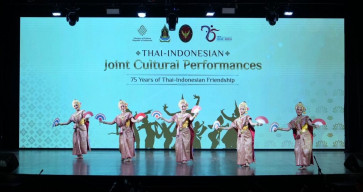Popular Reads
Top Results
Can't find what you're looking for?
View all search resultsPopular Reads
Top Results
Can't find what you're looking for?
View all search resultsMinister Bambang promotes new growth model in Azerbaijan
Debating economic growth: Indonesian Finance Minister Bambang Brodjonegoro (third right) speaks at a seminar on Asia's growth potential on the sidelines of the annual meeting of the Asian Development Bank (ADB) in Baku, Azerbaijan, on Sunday
Change text size
Gift Premium Articles
to Anyone
 Debating economic growth: Indonesian Finance Minister Bambang Brodjonegoro (third right) speaks at a seminar on Asia's growth potential on the sidelines of the annual meeting of the Asian Development Bank (ADB) in Baku, Azerbaijan, on Sunday. Other panelists are (from left) ADB President Takehiko Nakao, Chinaâs Finance Minister Lou Jiwei and Swiss delegate Beatrice Maser Mallor. (Courtesy of ADB) (third right) speaks at a seminar on Asia's growth potential on the sidelines of the annual meeting of the Asian Development Bank (ADB) in Baku, Azerbaijan, on Sunday. Other panelists are (from left) ADB President Takehiko Nakao, Chinaâs Finance Minister Lou Jiwei and Swiss delegate Beatrice Maser Mallor. (Courtesy of ADB)
Debating economic growth: Indonesian Finance Minister Bambang Brodjonegoro (third right) speaks at a seminar on Asia's growth potential on the sidelines of the annual meeting of the Asian Development Bank (ADB) in Baku, Azerbaijan, on Sunday. Other panelists are (from left) ADB President Takehiko Nakao, Chinaâs Finance Minister Lou Jiwei and Swiss delegate Beatrice Maser Mallor. (Courtesy of ADB) (third right) speaks at a seminar on Asia's growth potential on the sidelines of the annual meeting of the Asian Development Bank (ADB) in Baku, Azerbaijan, on Sunday. Other panelists are (from left) ADB President Takehiko Nakao, Chinaâs Finance Minister Lou Jiwei and Swiss delegate Beatrice Maser Mallor. (Courtesy of ADB)
D
span class="caption">Debating economic growth: Indonesian Finance Minister Bambang Brodjonegoro (third right) speaks at a seminar on Asia's growth potential on the sidelines of the annual meeting of the Asian Development Bank (ADB) in Baku, Azerbaijan, on Sunday. Other panelists are (from left) ADB President Takehiko Nakao, China's Finance Minister Lou Jiwei and Swiss delegate Beatrice Maser Mallor. (Courtesy of ADB)
Minister of Finance Bambang Brodjonegoro said in Azerbaijan on Sunday that the 1998 Asian economic crisis and the 2008 global financial crisis had prompted Indonesia to adopt a new growth model that emphasizes inclusive and sustainable development with less dependence on commodities and on international markets.
'In the 1990s, Indonesia and most other developing countries in Asia put too much emphasis on high growth led by exports, but the two crises prompted us to design and pursue a new growth model focusing on inclusive and sustainable growth,' Bambang told a seminar on Asia's growth potential on the sidelines of the annual meeting of the Asian Development Bank (ADB).
He added that the 2008 global financial crisis also gave us a highly valuable lesson that it is not economically sustainable to depend too heavily on commodities and the international markets.
'So in 2009 when most countries suffered economic contraction, Indonesia was still able to grow by 4.9 percent because we relied on domestic consumption as the main growth driver,' noted Bambang who talked as one of eight panelists, mostly finance ministers, at a seminar themed 'Rethinking growth potential and the growth model'.
He cited macronomic and financial sector stability, less dependence on commodities, downstreaming (manufacturing) of the natural resources and connectivity to global supply chains as several of the main ingredients for inclusive and sustainable growth.
Another panelist, China's Finance Minister Low Jiwei, shared Bambang's view in that China has also embarked on a new program to stimulate domestic consumption to spur growth.
'After the 2008 global financial crisis we became more realistic and set our new normal growth level from an average 10 percent down to 7 percent,' Jiwei noted.
ADB President Takehiko Nakao said the latest ADB Asian economic outlook report was still charting a positive picture for the Indonesian economy this year, predicting that the government's policy reforms will have an impact on economic growth sooner than expected.
The ADB forecast Indonesia to grow by 5.5 percent this year and 6 percent in 2016, far more optimistic than estimates from the World Bank and the International Monetary Fund (IMF), which said the economy would grow by 5.2 percent this year.
However, the ADB projection is based on the assumption that the new government's rapid reform momentum will be maintained, especially the acceleration in infrastructure building and budget disbursement.
Other panelists shared the same views that falling commodity prices are creating space for policy makers across the region to cut costly fuel subsidies and initiate other structural reforms.
The finance ministers saw this opportunity as providing the momentum to build frameworks that will support more inclusive and sustainable growth in the longer term, pointing out that with such diverse circumstances in the region, different keys are needed to unlock growth. (hhr)









